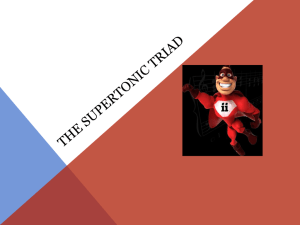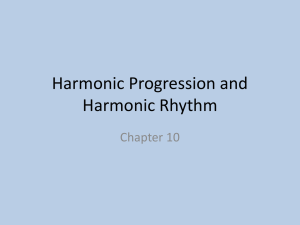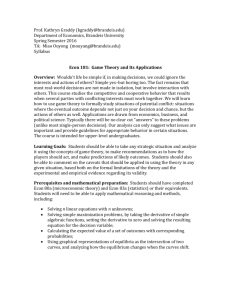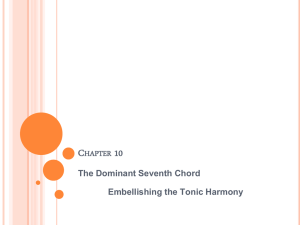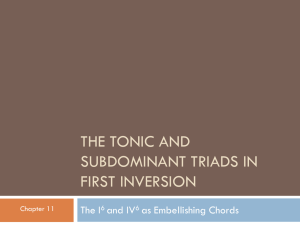Minor mode
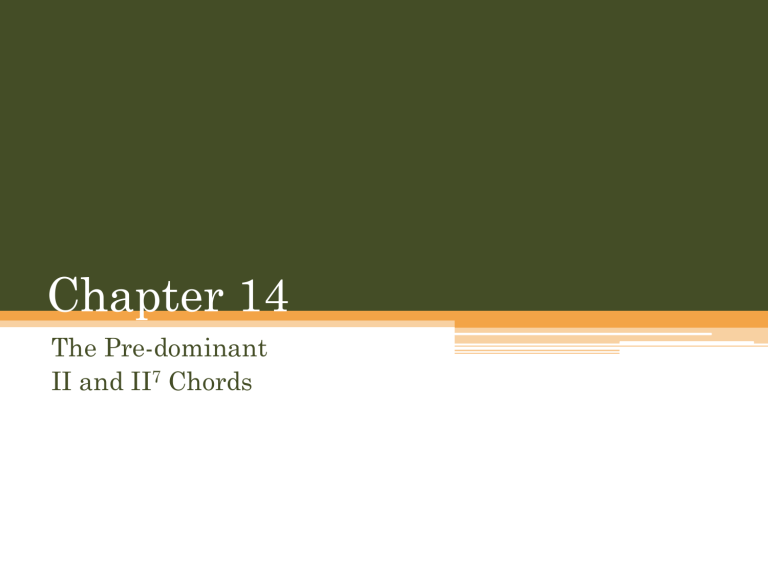
Chapter 14
The Pre-dominant
II and II 7 Chords
The Supertonic Family
• Major mode: supertonic sounds minor and its seventh chords is a minor seventh (m7)
• Supertonic occurs as ii and ii 6
• Seventh chord occurs as ii 7 ii 6/5 ii 4/3 and ii 4/2
• Minor mode: supertonic sound diminished and usually occurs as ii o6 - avoid using this in root position
• As a seventh chord is becomes half-diminished and appears in all four inversions ii ø7 ii ø6/5 ii ø4/3 and ii ø4/2
• Avoid using a minor triad built on supertonic using a raised 6 th . This is theoretically possible in the minor mode but sounds horrible and is almost never used
The Supertonic Family
• The various inversions of the supertonic seventh chord almost always use suspension figuration for the preparation and resolution of the chordal 7 th . An occasional passing motion may occur.
I 6 ii 7 V I
I 6 ii 6 ii 7 V I
Partwriting with Supertonic
Chords
• The progression of ii – V and ii 6 – V represent diatonic transpositions of V – I and V 6 – I; because their roots are a 5 th apart
• Use the same doublings you would in a
V (V 6 ) – I progression (Major keys)
▫ Double the bass in a root position chord
▫ Double the soprano in first inversion (ii 6 )
Partwriting with Supertonic
Chords
• Doubling the bass in minor ii o6 chords can produce parallel octaves (^4 - ^5) or a melodic skip of an augmented 2 nd (^b6 - ^#7) Ex. 14.3c
• When approaching a ii or ii 6 from a I 6 , be wary of using open structure; parallel 5 th may occur
• Root position I – ii progression will also give you parallels: move the upper voices in contrary motion to the bass or double the third in the ii chord
Partwriting with Supertonic
Chords
• All four tones should be present in a ii 7 chord
▫ Make sure the chordal 7 th is prepared and resolved correctly (by suspension)
• In root position ii 7 to root position V 7 , one of the chords must be incomplete, otherwise you will get parallel 5 th
▫ Omit the chordal fifth and double the root of the
V 7 or else do the same with the ii 7
ii 6 and ii 6/5 at the Cadences
• ii 6 and ii 6/5 can be considered close relatives to the root position IV; they are both predominants and share the same ^4 in the bass
▫ This is important at the authentic cadence
• The IV has a 5 th and
3 rd above the bass, the ii 6 replaces the 5 th with a 6 th and keeps the 3 rd
C: IV ii 6 ii 6/5
ii 6 and ii 6/5 at the Cadences
• I – ii 6 – V (7) – I or its seven chord inversion is one of the most frequent cadential formulas
▫ Strong conclusivity due to the stepwise descent of the soprano to the tonic (^3-^2-^2-^1) and the ^1 (or ^3) ^4-^5-^1 in the bass
• The supertonic seventh requires preparation of its seventh by suspension (^8-^8-^7)
^3 ^2 ^2 ^1
^3 ^2 ^2 ^1 c: i ii ø6/5 V i
I 6 ii 6 V I
Supertonic Harmony in Embellishing
Progressions
• Supertonic often occurs in short embellishing progressions in tonic expansion
▫ I – (ii – V 7 ) – I or i – (ii ø6/5 – V 7 ) – i 6
▫ These progressions avoid the cadential tonic formula and frequently originate and end on a weaker, inverted I chord
▫ These progressions should have parentheses placed around their Roman numerals
Supertonic Harmony in Embellishing
Progressions
C: I (ii V 6/5 ) I I 6 ii 7 V
I c: i (ii ø6/5 V 4/2 ) i 6 (V 6 ) i ii ø4/3
V
Supertonic Harmony in Embellishing
Progressions
• Consider your options when doing a chordal
Roman numerals analysis…things aren’t always what they seem.
avoid
C: I 6 (vii o6 ) I I (ii) I 6
The vii o6 is the most likely option for chordal motion to the tonic. Direct motion of ii to tonic is very rare.
This motion is usually used at the opening of a phrase.
Not ii
Prolongation of the Pre-Dominant
Function
• Triadic and seventh-chord forms of supertonic harmonies can be extended the same way tonic, dominant, and subdominant are in a phrase.
• Supertonic can be extended by using different inversions of the same chord; i.e. ii 6 – ii
▫ These inversions are usually bridged by using a first-inversion tonic chord
Prolongation of the Pre-Dominant
Function
• See Ex. 14.16D for the voice leading reduction
C: I ii 6/5 (6 ii 7 ) V I
• The orange Xs show the voice exchange between the right and left hands
Schumann: “*
*
68
*” (No.21) from Album for the Young Op.
